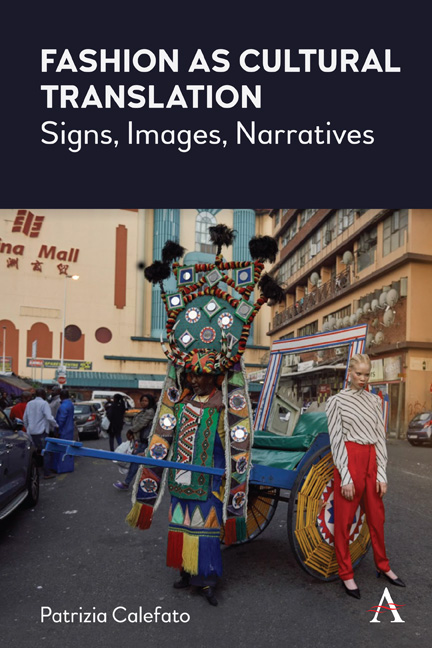Book contents
- Frontmatter
- Contents
- Introduction: Fashion as Cultural Translation in the Hyperconnected World
- Supplement to the Introduction: Fashion, the Hyperconnected World and Coronavirus
- 1 Time
- 2 Spaces
- 3 Fashion as Cultural Tradition: Italian Style
- 4 Fashion as Cultural Translation
- 5 Clothed Bodies
- 6 The Body as Text
- 7 Humans and Beyond
- 8 Fashion and the ‘Second Nature’
- 9 Fashion, Communication and Converging Media
- 10 Fashion Narratives in Visual Culture
- Conclusions: Fashion as an Idea about the Future
- References
- Index
- Frontmatter
- Contents
- Introduction: Fashion as Cultural Translation in the Hyperconnected World
- Supplement to the Introduction: Fashion, the Hyperconnected World and Coronavirus
- 1 Time
- 2 Spaces
- 3 Fashion as Cultural Tradition: Italian Style
- 4 Fashion as Cultural Translation
- 5 Clothed Bodies
- 6 The Body as Text
- 7 Humans and Beyond
- 8 Fashion and the ‘Second Nature’
- 9 Fashion, Communication and Converging Media
- 10 Fashion Narratives in Visual Culture
- Conclusions: Fashion as an Idea about the Future
- References
- Index
Summary
Fashion and the City
Between the end of the nineteenth century and the early twentieth century, fashion reached a high level of maturity in the West. Mass society, increased levels of consumption and the expansion of cities were the three elements which enabled the transformation of fashion from luxury into a communication system. Mass society can be defined as such because commodities are produced for large social groups: they are at the heart of consumption and their promotion can take place through new means of communication, including photography, journalism, cinema and advertisement. In urban areas, particularly in European and North American cities, fashion spreads in the streets, shops, windows, exhibitions and in the spaces of consumption and leisure.
Landscape – this is what the city becomes for the flâneur. Or, more precisely, the city splits into its dialectical poles. It becomes a landscape that opens to him and a parlor that encloses him. (Benjamin 2001, 263)
In this quote, Walter Benjamin incisively describes the late nineteenth-century city ‘landscape’ at the onset of mass society, a time when the processes of new urbanisation transformed large European capitals – first and foremost Paris – in cities of communication, new lifestyles, consumption and fashion. This landscape created the spatial conditions for the social subject of the modern city, the flâneur, to live and move while feeling at home. This social space was defined by the absence of clear boundaries between inside and outside, enabling the flâneur to feel simultaneously in an open space and in a private room.
Benjamin considered the Parisian ‘passages’ one of the most emblematic representations of the relationship between fashion and the modern city. He captures the image of the passage as a metaphor for the urban space and the transformation of the idea of the street. Thus, the street is not only a space of transit but also the physical and metaphorical space within which the city acquires its meanings through shared social practices. Writing in Paris at the end of the nineteenth century, Benjamin flagged the crucial transition of cities from spaces of circulation and movement, to spaces of exhibition and cult of commodities.
- Type
- Chapter
- Information
- Fashion as Cultural TranslationSigns, Images, Narratives, pp. 11 - 20Publisher: Anthem PressPrint publication year: 2021

